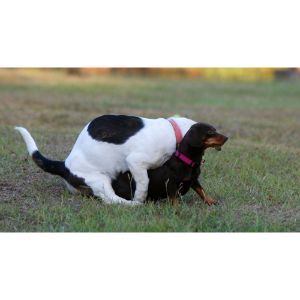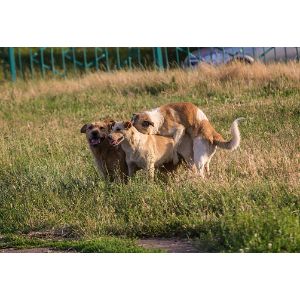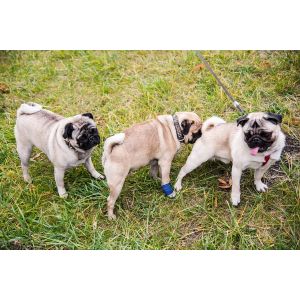Today we are going to talk about how to mate dogs breed successfully. So you want to be a dog breeder? Dog breeding is both a joy and a huge responsibility. To get it right, proper planning and preparation are required. If puppies have health issues or are brought back to you by dissatisfied buyers, getting it wrong can be heartbreaking as well as expensive.
Dog breeding can be a gratifying experience, but there are many factors to consider for success. There are numerous factors to consider before beginning the breeding process if you want to begin breeding dogs. It takes a significant amount of time, persistence, understanding, finances, and consultation with the veterinarian.
Other articles you would like: Will a Dog Breed While Bleeding and Animal Breeding For Disease Resistance
Mate Dogs Breed Successfully

The primary objective of breeding should be to improve the breed rather than to produce a large number of puppies. Numerous bad things can happen if proper precautions are not taken, including cognitive defects.
You’ll need extensive knowledge about your dog, its lineage, and the breed, including its abilities, flaws, common diseases, and so on. This can be accomplished by reading books, conducting research online, speaking with your veterinarians and expert breeders, and attending breeding counseling sessions at your veterinarian.
Preparing For Breeding

While the joy of watching new puppies enter the world is undoubtedly part of the experience, don’t allow this to divert from the fundamental idea of bringing new dogs into the world where they will have the best possible chance of being happy and comfortable.
Every offspring should be better than its parents. This implies that before breeding, you should consider factors such as demeanor, wellness, and health.
To provide the best atmosphere for mating, you should plan ahead of time and be confident in your ability to bear responsibility for all puppies produced for your dog, even after they’ve been adopted by new owners.
You might have to aid with concerns such as training and grooming, and in certain situations, you may need to keep a returned dog if there are concerns. Ethical breeders always have a return policy that states that
The Fundamentals
Once the dam is on heat and preparing to mate, nature usually takes over and the breeding occurs effortlessly. Follow these guidelines to assure successful breeding while causing no harm to either side.
Choosing Your Dogs
When choosing a dam or stud, it is imperative that they have good temperaments, no genetic flaws or health conditions, and are active and healthy.
During the breeding consultations, your veterinarian will be able to do the necessary tests to ensure that they are both healthy enough and fit for breeding a healthy purebred litter without passing any diseases or genetic conditions on to the puppies.
The dogs you choose to mate must also be of proper age, particularly females, who should be at least a year old and have completed their full heat.
Choosing The Dam
- Only breed from female dogs who are healthy, strong, and have a decent personality. Before mating, the dam must undergo health examinations to determine whether she has any illnesses that could be passed on to her babies.
- Age should be considered as well. When trying to mate with a bitch, it is advised that she be at least one year old and when a dog reaches the age of eight, the risks with mating and whelping increase.
- Ensure the dam is properly fed and has had all necessary vet treatment before mating. You should also begin keeping track of her reproductive cycles, which will let you forecast the delivery date of her litter if she becomes pregnant.
- If you decide that your female dog is not suited for breeding, it is best to get her spayed to avoid unwanted pregnancies and potential health problems.
Selecting The Stud
- The stud you select should have a complementary lineage with your bitch as well as a suitable history of health. Before breeding, the stud should be tested for genetic disorders specific to that breed.
- You can always make a crossbreed litter. Certain mixed-breed dogs are quite popular because they combine the greatest traits of two pedigrees.
- While crossbreeding can produce a unique-looking dog that frequently avoids congenital disorders connected with the parents’ breeds, it is also a risky practice.
Pay Attention To The Heat Cycle

Female dogs go through a natural reproduction cycle and tracking this cycle each month can help you determine when you should let your dogs breed naturally. When you observe bloody discharge flowing from the dog’s vulva, you know it’s the first day of her cycle.
You may not always detect the exact first day of your dog’s cycle, particularly if bleeding is minimal at first. Additional changes, like behavioral changes, may indicate that your female is in heat. It may take several months of monitoring your female’s cycle to identify the true starting day.
To determine the most precise start date, take more notice of any unexpected changes in behavior, activity levels, or feeding habits around the time your dog generally begins to bleed.
Avoid breeding your female dog during her first heat cycle. It is preferable to wait until your female dog is at least a year old and two years for large breeds before starting to reproduce. This will allow you to understand her cycles, determine the average number of days they last, and recognize indicators that she is about to go into heat.
Breeding Must Be Done On Correct Days Of The Heat Cycle
On days 9, 11, and 13 of their cycles, females are most fertile. Both males and females must have the opportunity to breed these days since this increases the chances of your female having a litter.
Understand that you may not know when your female’s cycle begins. You should combine the male and female the days before and after your dog’s expected reproductive days.
Count The Days
Keep in mind the first day that your dam begins to bleed. Your female will be fertile later in the cycle, rather than on the first day of bleeding. Around 10 days into the cycle, the female will generally allow a male to mount her. Let your female breed throughout her normal cycle if you want to breed naturally.
Maintain A Healthy Body Weight
Female dogs who maintain a healthy weight are more prone to conceive and have successful pregnancies. A female that is underweight or overweight may have trouble conceiving and carrying offspring to birth, while a stable diet and weight promotes a healthy pregnancy.
Consult your veterinarian about your dog’s weight. Your veterinarian can advise you on a diet and exercise regimen which will keep your female dog at an ideal weight for her age and breed.
If your female is overweight or underweight, you should try to get her to a healthy weight before breeding her.
Give Both Dogs a Well-Balanced Diet
Healthy dogs are more prepared for mating, and a healthy diet is essential for your pet’s health if you are planning to make them breed. Feed your dog the recommended intake of nutritious dog food to promote general wellness.
Dogs’ nutritional requirements vary depending on breed and age. Consult your veterinarian about a healthy diet for your dog. Most dogs respond better to planned meals than to random feeding.
Offer healthy snacks to your dogs to praise them for excellent behavior while also maintaining their weight in check. As healthy treats, give your dog some vegetables and fruits, such as a baby carrot, apple slices, a couple of bananas, or a green bean.
Keep Your Dogs Exercised And Healthy
Dogs require exercise to stay healthy. Exercise can also help both dogs maintain a healthy weight, which promotes overall fertility. Try to get your dog some exercise every day, whether it’s a walk or simply playing about the home.
Larger, more energetic dogs may require more physical activity than smaller ones. Consult your veterinarian about how much exercise your dog requires each day. If your dog has a lot of energy, you might consider getting a fenced-in yard so he may run about outside during the day.
Groom Your Stud
To avoid infections and diseases and other difficulties during breeding, male dogs must maintain a clean genital area. Ensure the hair around a male’s genitals is also trimmed. This will assist the male in effectively mounting a female, so facilitating natural breeding.
Don’t Overfeed Your Dogs
If a male dog is overfed, he may lack the energy to mate. You want your male to be as lively and energetic as possible. On the day you allow the dogs to mate, restrict food until your dog has successfully bred with the female. Feed the male the day before mating and again after he has finished mating with the female dog.
Keep Your Dogs Calm
If you want natural breeding as opposed to artificial insemination, both dogs must be calm. Breeding is less likely to occur when dogs are stressed or scared. If the male and female dogs do not already know each other, arrange for them to meet a few days before mating.
You should also maintain a quiet environment. Choose a location free of loud noises and other disturbances as frightened or intimidated dogs may not mate.
Do Not Allow Yourself To Become a Distraction

As a dog breeder, you must be constantly present to watch the breeding process, particularly if it is your dog’s first time mating. It is recommended to keep a watch on the couple to ensure that no problems occur, such as troubles with penetration, locking difficulties, or overall dog hostility.
If there are no evident issues, you should endeavor to stay unseen. If you are lurking around the mating area, your dog will regard you as a great distraction, and they will just want to play and engage with you instead of their partner.
This is why it is preferable to remain silent and avoid interfering with the natural mating process. If your dog sees you, his or her attention will be drawn to you and what you are doing, possibly delaying breeding.
Let The Dam Drive
Allow the dogs to interact together, but keep an eye out for symptoms of aggressiveness, specifically, if the bitch hasn’t had much exposure to other dogs – she may not recognize that this lovely male is a lover, not a fighter. You can supervise the mating, which is an important aspect of breeding if she is collared and on a lead.
Allow the two dogs to socialize. It could take some time. You may have to keep your dam on a lead for a good few hours before she gets ready to mate with the dog, but that’s just the time you’ll have to spend if you want good breeding.
On the breeding date, both dogs are relaxed and comfortable seeing each other instead of nervous or scared of the other unknown animal. Such interactions can also be used to determine whether the stud and dam have comparable cheerful personalities, which increases the likelihood that these attributes will be transferred onto the litter if they mate.
Use a Table

If you’re having trouble getting two little dogs to mate, this strategy can come in handy. If you position both on a table, you can try together to guide them into position and keep them steady once they’re there.
Of course, always look out for the comfort of your girl. If this is her first experience, expect the bitch to need a little more “courtship” period than if she’s done it before, so give her the support she wants.
Look Out For Slip Mating
Slip mating happens when the dog’s penis becomes enlarged inside the dam but slips out before they “lock.” This can be quite frustrating for people who are attempting to assist in breeding since the dog will mount the bitch, hop off, mount her again, jump off, and keep going.
If the dam is in heat, she will certainly go out of her way to please the dog, so it’s usually better to simply let things work themselves out – occasionally dogs don’t like it when you intervene with their breeding.
You can keep the bitch stable, but it’s probably a lot better if you leave the dog alone, at least until you’re certain he’s locked within her. Then you can stabilize him or have someone else steady him for a brief time till his knot expands.
Even if you can’t keep the dogs still, don’t rule out breeding – as long as the dog has discharged within the bitch, possibilities are a litter is on the way. If he hasn’t ejaculated yet, he’ll most likely attempt again until he succeeds.
Be Wary Of Early Withdrawal

If the dog’s penis is expanded but he has not impregnated the bitch, you will note that his penis is still fully distended once he pulls back. You will very certainly detect semen flowing from the tip of the penis, just as you would if a tie had happened.
If you desire a litter, you must now collect the leaking semen in a wide-mouthed jar or bowl. Then, draw it up with an eye dropper or turkey baster and inject it into the bitch. This is best accomplished if you can persuade her to lie on her back since this will put her in the optimum position to acquire the semen.
Look Out For The Tie
When the bitch and the dog tie up together, this is the finest sort of mating. They usually lock for anywhere from 10 minutes to an hour. At this point, the dog may attempt to assume some unusual postures, such as turning around so that he and the bitch are locked back to back.
At this moment, the dog and bitch may even lie down and relax together. You don’t have to do anything right now except check and ensure they’re not pulling each other around, so if that appears to be the case, attempt to block them from moving and damaging each other.
Post-Mating Care
There are a few things you may do after the dogs have mated to increase conception. After mating, you may need to put the female in a cage for 30 minutes. You might want to avoid urination since it will aid in conception.
After mating, ensure that the male’s penis retracts. In most instances, it will automatically retract after 30 minutes. If this does not occur, you may have to retract the penis on your own.
Conclusion For How To Mate Dogs Breed Successfully

If you’re thinking about becoming a dog breeder, there are a few things you need to know. First and foremost, it’s a huge responsibility. You’ll be responsible for the health and wellbeing of not just one dog, but multiple dogs – and their litters.
That means regular vet check-ups, a nutritious diet, and plenty of exercises. It’s also important to do your research before you start breeding. You’ll need to choose the right breeds to avoid health problems down the line, and you’ll need to keep careful records of each litter.
Finally, remember that breeding dogs is a business – so you’ll need to be prepared to invest time and money into making it a success. But if you’re up for the challenge, breeding dogs can be a rewarding experience. Good luck!
You will also like:
For more information about How to become a dog breeder, check out the video below:

